Orchid aerial roots: what to do and how to care for them
Since there are not always enough green areas in cities, residents are trying to plant more flowers in their apartments. They decorate the interior of the room and purify the air by saturating it with oxygen.
Orchid is considered a fashionable and popular indoor flower. She needs special care.
The appearance of various metamorphoses with a plant often causes a misunderstanding among flower growers: what to do with aerial roots in an orchid.
What is it
Aerial roots are the root portion that grows on the soil surface. They emerge from the soil in a pot or form from stem nodes on the stem. Sometimes the orchid grows overgrown with aerial roots very densely, but there may be very few of them.
The roots of the flower are responsible for fixing the plant in the selected area. After all, orchids do not grow in the ground, but on trees. The roots also supply the entire plant with moisture and nutrients.
Aboveground roots of a plant often appear. This does not mean that he became cramped in the pot, it was just that the time had come for the development of air outlets.
How do they look
These roots do not improve the aesthetic appearance of the plant, but nothing should be done with them - the natural development of the plant is taking place.
In appearance, the air roots are tubular or flat processes.
If they do not have enough moisture, they have a silvery color, then they turn gray and whitish. In this case, it is required to water according to the rules - put the flowerpot in a container with water. After it, the color of the roots turns bright green - this is a sign of a healthy flower and root system. Aerial roots should be soaked in water for a couple of minutes or sprayed with water.
Root structure and functions
The roots emerging from the soil are similar to standard orchid growths. Their difference lies in the fact that they grow in other places. In structure, it is slightly thicker than underground, but they are the healthiest, because they appear in natural conditions of growth of orchids.
Domestic flowers grow on a substrate of pine bark and sphagnum moss, which is close to their natural growth on trees. Over time, the mixture degrades and requires replacement. The roots are exposed to infection and rot.
The plant is looking for a new source of moisture and nutrients, so its roots twist and unfold in different directions. Many remain in the substrate and some become airy.
The structure of these orchid roots is represented by the following layering:
- central cylinder;
- velamen (integumentary part, consisting of hardened dead tissue cells);
- parenchyma of the cortex.
Velamen is like a sponge - it is similar in structure to it, it absorbs well and gives off moisture well.
What are they needed for
The health and development of a plant depends on the condition of the roots. Air branches perform the following functions:
- Fastening and support - epophytes completely abandoned underground roots and use aboveground roots for fastening to trees.
- Absorb moisture - they store it in vascular bundles under a layer of sponge for use in dry times.
- Getting nutrients from water, air and symbiosis with mushrooms.
- Photosynthesis - like leaves, they convert light energy into carbohydrates, which are needed for the development of the orchid.
In home growing, some of the functions of these branches are simplified.For example, they do not need to be fixed on tree branches, because they are in pots.
Reasons for the formation of aerial roots
Numerous branches of roots appear in an orchid for the following reasons:
- Increased room temperature. This phenomenon occurs more often in winter. The flower pots are placed on the windowsill, where they are heated by radiators. They also dry the air a lot.
- Excess moisture in the substrate. To prevent root rot from appearing, the plant begins to quickly form additional roots and it becomes cramped for them in the pot.
- Moisture deficiency. With insufficient watering and dry indoor air, the plant also releases extra roots to collect more moisture.
- Lack of lighting. The flower forms many extra roots for the full implementation of photosynthesis. Otherwise, the roots in the substrate will begin to rot.
- Dense soil in the container. It is forbidden to add turf and clay to the substrate and tamp it. It must be porous in order to be well ventilated. Otherwise, the roots will rot.
- Sour or salty substrate. If you overuse fertilizers or water it with water with a lot of salt, then it will begin to form new roots. You can notice a bad substrate by the white bloom on it. You need to completely replace it when a similar problem occurs. Rinse the roots with water and do not feed until the plant is fully restored.
If there are few air branches, no measures should be taken. It is necessary to revise the conditions for caring for the plant and the irrigation scheme. If there are too many roots and they have begun to rot or become infected with a fungus, then emergency measures must be taken.
What to do with them
If too many root branches have formed on the surface of the soil, you need to identify the cause of their appearance and begin to eliminate it. Often the flower itself shows the cause of multiple root formations. You need to take a close look at it and quickly take action for changes in its development.
What to do if there are too many of these roots
If there is discomfort in the plant and its owner from multiple aerial roots, it needs to be transplanted into a larger pot. It is impossible to remove them if they are not sick and not damaged, since this way you can kill the flower itself.
The size of the pot is 3 cm wider than the horse system. You should not push the roots into the substrate yourself, they will independently find a place convenient for themselves. The substrate must be replaced with a new one. A large container will cover the above-ground roots, which will solve the unpleasant problem.
When transplanting
The orchid sometimes needs to be transplanted into a new container. If this is due to the huge branching of the air branches, the growers do not know what to do. Given their volume and condition, you can act in different ways:
- Carefully examine and remove dried and injured roots.
- Carefully undo the intertwined processes.
- If there are too many roots, you can trim off a third of the roots. It won't hurt orchids at all.
- Part of the roots can be dug in, the root collar can be left outside.
The cut sections must be dried and treated with a disinfecting solution. When there are few aboveground roots, they do not need to be removed or buried in. If you take good care of your orchid, they will find a comfortable place for themselves.
How to trim them
Sometimes roots need to be removed if they are injured or diseased. If the plant is cramped, you need to cut off some of the air branches and transplant into a larger pot.
It is recommended to prepare the tools before starting work. The pruner or knife must be sharp. They need to be disinfected by moistening the blade with chlorhexidine, vodka or cologne so that no infection gets to the cut.
You need to trim in stages:
- Release the flower from the pot.
- Rinse the roots under running water.
- Dry the plant at 20-25 degrees for 5-6 hours.
- Look carefully for damage, in these places press on the root, a liquid with a bad smell will come out of it.
- Remove dried and injured roots. Leave the plant to dry for 2-3 hours.
- Powder the sections with crushed activated carbon.
If these funds are not available, you can sprinkle with ordinary cinnamon, since it is a natural antiseptic. Then transplant the flower into a new container with a renewed substrate from pine bark and sphagnum moss. Provide illumination of the plant for 20 hours a day, supplementary lighting with fluorescent lamps.
How to help dry air roots
Why do air branches begin to dry? This question presents the following reasons:
- Lack of moisture. If the moisture in the accumulators runs out, the root cells stop dividing, die off and begin to dry out. A living root has an olive or light green tip. At the same time, they are tough and elastic to the touch, green in color. The dried area is brown, yellow or black. It looks wrinkled, deformed and reduced in volume. Only such a root needs to be removed.
- Chemical burn from fertilization or irrigation with poor-quality water. The roots of the flower are quite delicate. In nature, they absorb rainwater, which is soft and clean. She did not develop protection against chemical burns, therefore, it is required to water the flower with settled water with a small content of mineral salts. You need to feed the plant more often, but with a weak solution - ½ or ¼ of the dose recommended on the package. Top dressing under the root is required to be given after they have been watered abundantly with water to avoid burns.
- Root damage. The spongy layer of the appendix is not a reliable protection against damage. If the pot with the plant falls or the root breaks accidentally, then the entire system is injured, because they are fragile. Fractures lead to the death or shrinkage of the entire branch of the root or part of it.
- Infections. The plant can get infected with any infection and fungal disease. Improper watering can provoke root rot, including dry. It is necessary to conduct proper watering of the plant and carry out preventive actions against infection.
The dried out processes must be gradually brought back to normal. Do not put them in a bowl of water, this will aggravate the situation. To gently relieve stress from the plant, it must be watered with the whole epin. It relieves stress and activates the defenses of the plant.
As the roots dry out, do it again. Then dry and dip the pot in room temperature water. After the roots have dried, immerse them in water again for 5 minutes. Then water as usual and let the roots dry. Resuscitation lasts more than one day, but the plant will benefit from it.
Common mistakes novice florists make
Newbies in floriculture try to give the flower a presentable look and make the following mistakes:
- Removal of aerial roots that spoil the appearance of the plant. This is the wrong decision and you cannot trim them for several reasons. Firstly, the plant tries to replenish moisture and nutrient reserves through new roots. Secondly, the root cut is an open wound that can become the site of infection. Thirdly, at the site of root cutting, several roots can form at once.
- When planting or transplanting orchids, flower growers often stuff pot substrate and ram it down. This is unacceptable for orchids, as they need a loose substrate for air to penetrate to the roots.
- Some growers put aerial roots in a pot and cover with a substrate. You do not need to do this, you can easily introduce an infection into the root system.
The flower requires careful self-care. For example, it only needs to be watered from a sprayer. If a stimulant is added to the water, then they should be irrigated with roots and leaves, being careful not to fall on the peduncle.
Prevention of air branching
If aerial roots spoil the aesthetic appearance of the plant, then you can simply prevent their formation. You can do it this way:
- Adjust the watering of the plant so that there is no excess moisture, but the substrate does not dry out too much.
- Add additional lighting to the plant. Increase the time of daylight.
- Transplant the flower into a spacious pot.
- Loosen the potting medium periodically.
It is necessary to choose transparent containers for it - this will enhance the process of photosynthesis. Occasionally, areas with a darkened brown crust appear on the aerial roots. No need to panic - due to excessive feeding with mineral fertilizers, salt deposits form on the root surface.
These are brown spots, but at the same time, gray spots indicate burns when watering with too much fertilizer. Such damage is not dangerous for the flower, but it is recommended to do feeding less often and with less saturated solutions.
Growing an exotic orchid at home requires some knowledge and skills. The plant has good vitality and, if a problem occurs, it should not be scrapped. It is necessary to pay more attention and care to the flower, and it will be reborn, allowing the owners to fully enjoy its magnificent flowering.
Watch the related video:



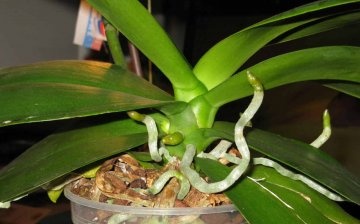
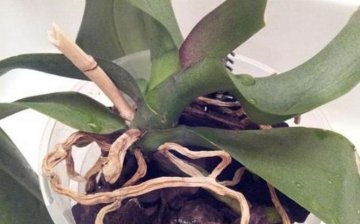
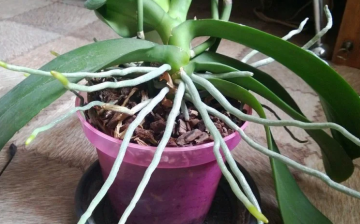



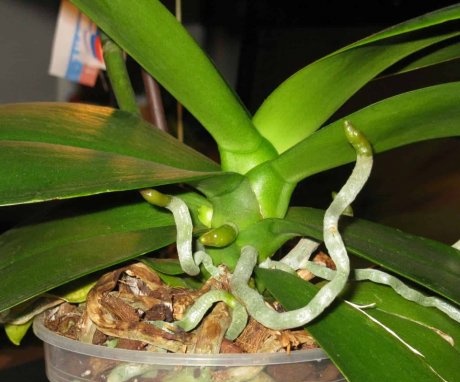
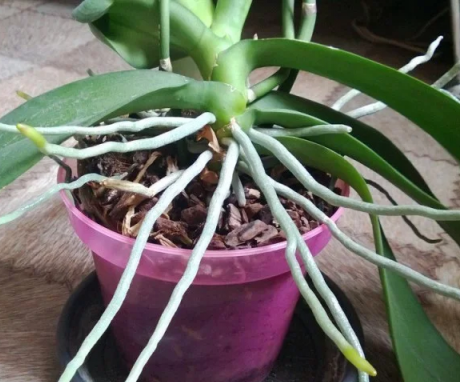
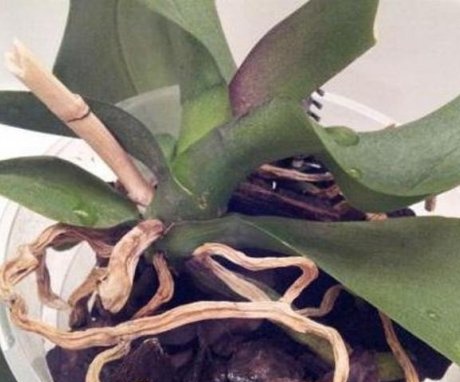
Our phalaenopsis orchid also has aerial roots. There are not many of them, but they are. In the photo in the article, the orchid has 6 leaves, which means that it has excess moisture when watering. This flower should have 4 leaves, if less, there is little moisture, and more means there is a lot of water. We do not spray the orchid, I read that aerial roots can take moisture from the air.
Maybe I'm not doing it right at all, but I don't do anything with orchids at all and try not to even move them. They grow and bloom for a whole year, I rarely transplant and then only if necessary. There are few aerial roots. And the side of the world is also important.